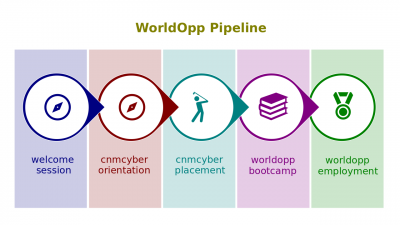Industries and Specialties

Industries and Specialties is the second lectio (or lesson part) in the Introduction to Employment lesson. The lesson itself is the second in CNM Cyber Orientation. Consequently, the Orientation is the first stage of WorldOpp Pipeline.
This wikipage presents its full script and those test questions that are related to that lectio.
Contents
- 1 Script
- 1.1 Overview
- 1.2 Economy
- 1.3 Economy Segment
- 1.4 Industry
- 1.5 Industrial Classification
- 1.5.1 Raw Materials Industry
- 1.5.2 Infrastructure industry
- 1.5.3 Manufacturing industry
- 1.5.4 Transportation industry
- 1.5.5 Digital industry
- 1.5.6 Market exchange industry
- 1.5.7 Enterprise support industry
- 1.5.8 Public service industry
- 1.5.9 Healthcare industry
- 1.5.10 Human development industry
- 1.5.11 Living-sustaining industry
Script
Overview
- Welcome to Industries and Specialties. In this presentation, we are going to take a look at the basic concept of Economy, Economy Segment in terms of Enterprise sectors further moving on to Industry, highlighting Industries or Industrial Classifications and Specialties. Let's begin.
Economy
Economy is the system of human production and consumption of raw materials, goods, and services, which may range from the prosperity of a single household to the wealth of nations. The term, economy, may also refer to the way of how wealth is generally created and used or, particularly, to the careful use and management of money, time, energy, etc. Overall it is the state of a region in terms of production and consumption of goods and services and the supply of money, also dealing with careful management of all these resources. The Three-Sector model divides the economy into three sectors of activity also known as Economic sectors.
Economy Segment
It is an area of economy. Economy segment refers to the nature and direction of the economy in which a company competes or may compete. Two major conventional classifications divide enterprise depending on
- Their Ownership
- Products they produce
- Primary Sector
- Secondary Sector
- Tertiary Sector and optionally
- Quaternary Sector
- This classification also fits into economic phases of precedence, since lower levels of the economy emerged before higher levels and higher levels depend on lower ones. However, every enterprise usually produces some mix of products, so it can belong to several segments
Both classifications use the term sector . Neither of the classifications takes single households into account.
Primary Sector
Primary sector (primary degree of the economy, primary stage of the economy) is the economy segment that groups those enterprises that extract from nature, renew, and pre-process those raw materials or substances such as agriculture and mining products that the manufacturing industry will further process to create those goods and services that can be eventually consumed by end-users. Mainly, it deals with the production of raw materials.
Secondary Sector
Secondary sector (secondary degree of the economy, secondary stage of the economy). The economy segment that groups those enterprises that produce physical goods to be eventually consumed by end-users. Mainly, it deals with carrying out the manufacturing.
Tertiary Sector
Tertiary sector (tertiary degree of the economy, tertiary stage of the economy). The economy segment that groups those enterprises that produce physical, non-digital services such as retail, tourism, traditional banking, entertainment, etc. Mainly, it deals with providing sales and services.
Quaternary Sector
Quaternary sector (quaternary degree of the economy, quaternary stage of the economy). One of two:
- The economy segment that groups those enterprises that produce digital products; OR
- The economy segment that groups those enterprises that do research and design new products.
Mainly, it includes knowledge-oriented economic sector such as information technology,media, research and development; information-based services such as information-generation and information-sharing; and knowledge-based services such as consultation, education, financial planning etc.
Industry
The part of any economy segment that groups those enterprises that create a particular type of product. A group of companies that are related based on their primary business activities form an industry.
Industry Relations
The systematic study of attitudes, motivations, and behaviors that two or more legal entities within the same industry assume toward each another.
Industry constituency
Any group of legal entities that are involved in, served by, patronize, support, offer representation, or are likely to be involved, served, patronize, support, or offer representation for a particular industry.
Industrial Classification
Any economic taxonomy that groups businesses based on their products and/or production processes, as well as on their selling, marketing, and/or social appealing techniques into industries. There are a few taxonomies; CNM Cyber utilizes its own CNM industry classification.
Raw Materials Industry
An alternative name for the primary sector.
Infrastructure industry
The industry that groups those enterprises that supply and present all substances, materials, and properties such as energy, water, buildings, and roads that human beings, other entities, and their equipment are needed to function, as well as dispose and/or utilize the processed substances, materials, and properties. This industry includes both construction and utility enterprises.
Manufacturing industry
The industry that groups those enterprises that process raw materials into those goods and services such as food, clothing, paper, and machinery, that can be eventually consumed by end-users.
Transportation industry
The industry that groups those enterprises that deliver human beings and goods from one geographical point to another. In addition to transport enterprises, this industry includes warehousing and postal services.
Digital industry
The industry that groups those enterprises that produce software and/or provide their customers with software-based services such as broadcasting, telecommunication, multimedia, data processing.
Market exchange industry
The industry that groups those enterprises that buy, sell, and/or support the market exchange of products that have been produced by other entities. This industry includes franchising, real estate, wholesale, retail trade enterprises.
Enterprise support industry
The industry that groups those enterprises that support enterprise efforts through banking, insurance, investment management, accounting, management consulting, and legal services.
Public service industry
The industry that groups those enterprises that provide the general public with defense, public administration, public safety, and compulsory social security services.
Healthcare industry
The industry that groups those enterprises that provide their customers with pharmacy and medical services.
Human development industry
The industry that groups those enterprises that provide its customers with educational, training, or community outreach services.
Living-sustaining industry
The industry that groups those enterprises that provide its customers with cleaning, entertainment, library, recreation, rental, tourism, wellness and other living-sustaining services.
